Majority of the occupied housing units were single houses
Of the total number of occupied housing units in Agdangan, 3,164 or 95.9 percent were single houses. This was followed by occupied housing units in duplex with 80 (2.4%), in apartment/accessoria/rowhouse with 44 (1.3%), and in other multi-unit residential units and commercial/industrial/agricultural units, both with 6 (0.2%). (Table 1 & Figure 1)
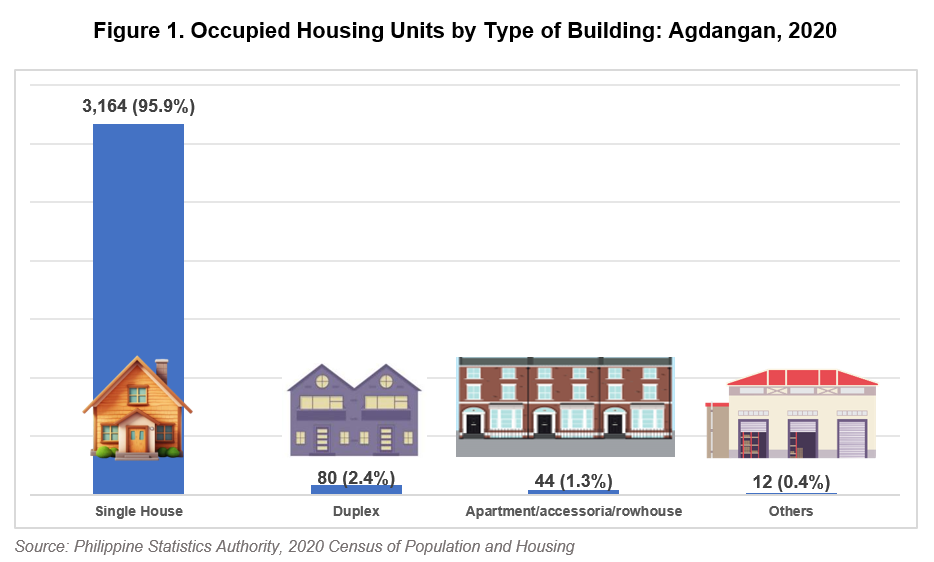
Majority of the occupied housing units have strong materials as outer walls and roofs
In 2020, majority of the occupied housing units in Agdangan had outer walls made of concrete/brick/stone (60.3%) followed by those made of wood (13.8%). On the other hand, some of the occupied housing units had outer walls made of half concrete/brick/stone (13.1%) and half wood, while others had outer walls made of bamboo/sawali/cogon/nipa (10.3%). (Table 2 & Figure 2)
Nine in ten (89.5%) of the occupied housing units in 2020 had roofs made of galvanized iron/aluminum. This was followed by the proportion of occupied housing units with roofs made of cogon/nipa/anahaw and wood/bamboo with 7.5 percent and 1.3 percent, respectively. (Table 2 & Figure 2)

Four-fifths of the housing units had concrete as construction materials of the floor
Four in every five occupied housing units (81.9%) had concrete as construction materials of the floor. Other construction materials of the housing units were earth/sand/mud (11.6%), bamboo (3.0%), wood (2.8%), coconut lumber (0.3%), and makeshift / salvaged / improvised (0.1%). (Table 3 & Figure 3)
Meanwhile, around 39.3 percent of the occupied housing units had cement/brick/stone as the finishing materials of the floor. Other finishing materials of the floor were ceramic tile/marble/granite (23.8%), linoleum (17.2%), wood plank (2.9%) vinyl/carpet tile (0.4%), wood tile/parquet (0.3%), and others (0.4%). Moreover, one in six of the housing units (15.5%) did not have any finishing materials of the floor. (Table 3 & Figure 3)
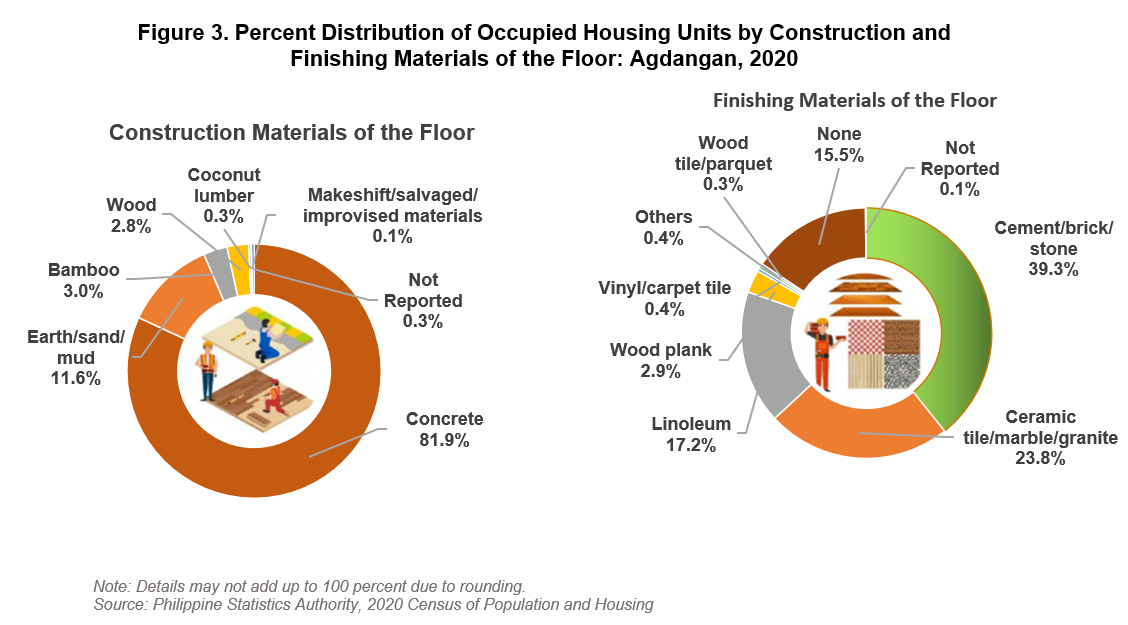
Nine in ten occupied housing units were one-storey
The majority, or about 3,044 (92.2%) occupied housing units were only one-storey buildings. Two-storey buildings followed with 250 (7.6%), while three-storey buildings accounted for only 6 (0.2%). (Table 4 & Figure 4)
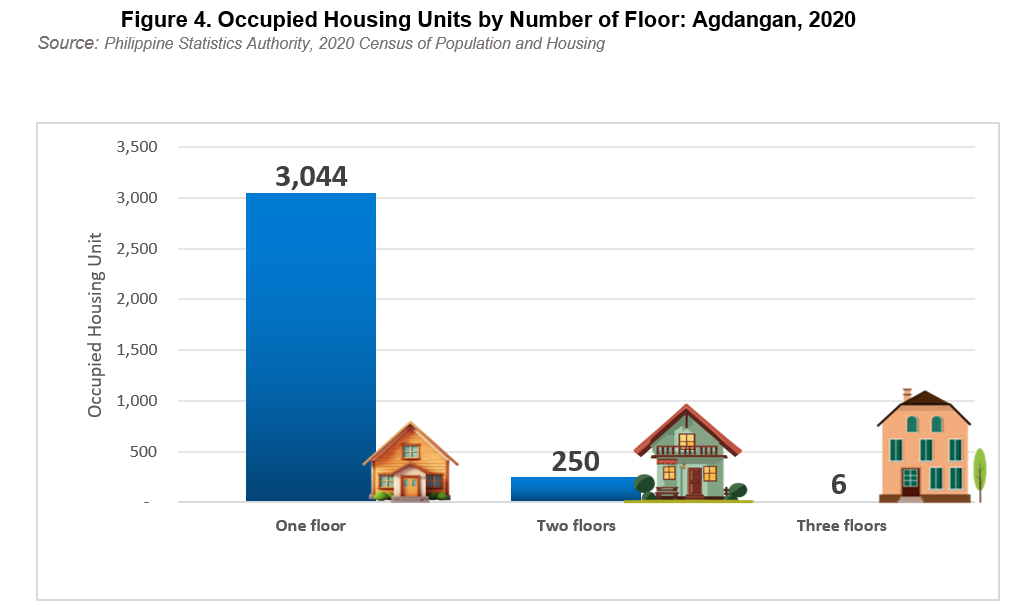
Three in every four occupied housing units needed minor or no repair at all
Almost three in every four occupied housing units (74.2%) needed minor or no repair at all. Meanwhile, the proportion of occupied housing units needing major repair comprised 15.5 percent. (Table 8 & Figure 9)
Moreover, the rest of the occupied housing units were categorized as follows: unfinished construction (7.2%), dilapidated/condemned (1.2%), under construction (1.1%), and under renovation/being repaired (0.7%). (Table 5 & Figure 5)
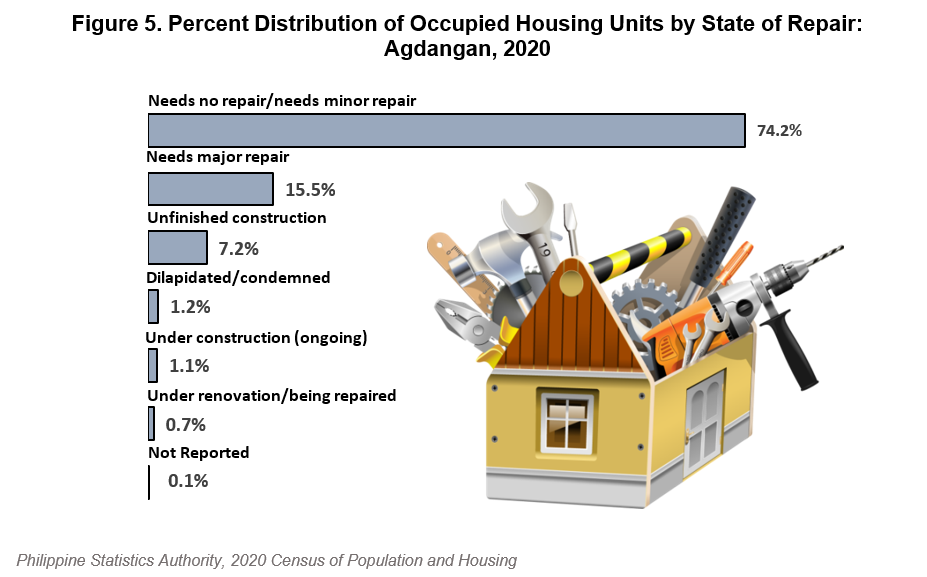
Two in five occupied housing units in Agdangan Quezon were built within the decade prior to the 2020 CPH from 2011-2020
Two in five (40.7%) of occupied housing units in Agdangan were built between 2011 and 2020, while 21.0 percent were built during the period 2001 to 2010. The remaining 33.1 percent were built more than 20 years prior to the 2020 CPH with 15.5 percent during the period 1991 to 2000, 8.0 percent during the period 1981 to 1990, and 9.6 percent in 1980 or earlier.
Meanwhile, about 5.1 percent of the occupied housing units in the municipality were of unknown construction years. (Table 6)
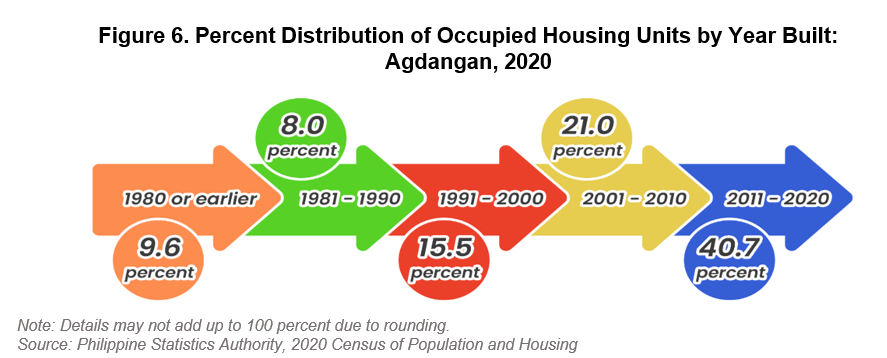
One in every five occupied housing units had a floor area of less than 20 square meters
In 2020, occupied housing units with a floor area of 20 to 29 square meters (210 - 317 square feet) accounted for 19.5 percent of the total occupied housing units. This was followed by housing units with floor area of less than 20 square meters (less than 209 square feet) comprising 19.4 percent, housing units with a floor area of 30–49 square meters (318–532 square feet) sharing 15.8 percent, and housing units with floor area of 50–69 square meters (533–748 square feet) accounting for 14.8 percent. (Table 7 & Figure 7)
Meanwhile, occupied housing units with a floor area of 120 square meters (1,287 sq. ft.) or larger accounted for 12.7 percent. Those with a floor area ranging from 70 to 89 square meters (749-963 square feet) accounted for 9.3 percent, while those with a floor area of about 90–119 square meters (964–1,286 square feet) accounted for 8.5 percent. (Table 7 & Figure 7)
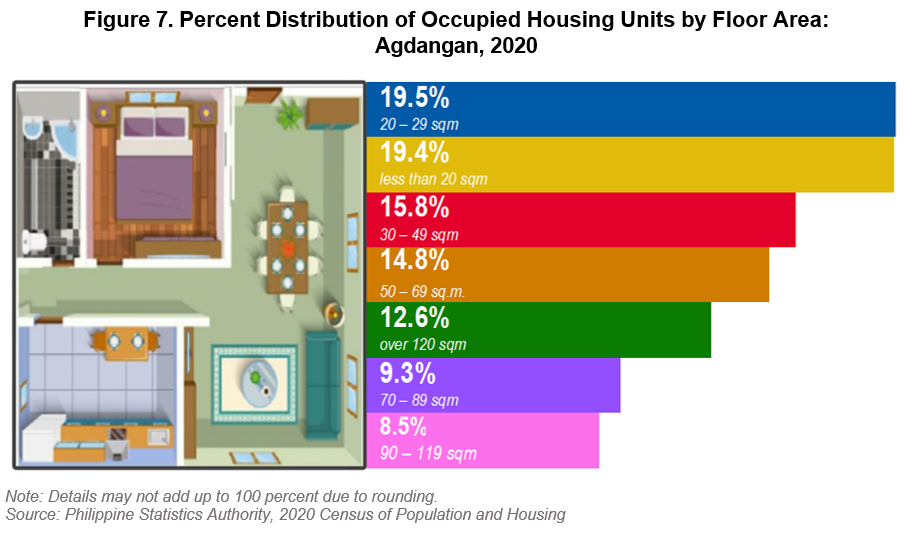
Almost half of the households occupying a housing unit owned or had owner-like possession of the house and lot they reside in
Of the 3,350 households, almost half (45.5%) owned or had an owner-like possession of the house and lot they occupied. Moreover, 39.9 percent of the households owned the house while occupying a rent-free lot with the consent of the owner. Furthermore, 7.0 percent rented house and lot for free with the consent of the owner, 6.1 percent rented the house/ room, including the lot that they occupied, 0.8 percent owned house and rented lot, 0.5 percent owned the house, rented lot for free without consent of owner and 0.2 percent rented the house and lot for free without consent of owner. (Table 8 & Figure 8)
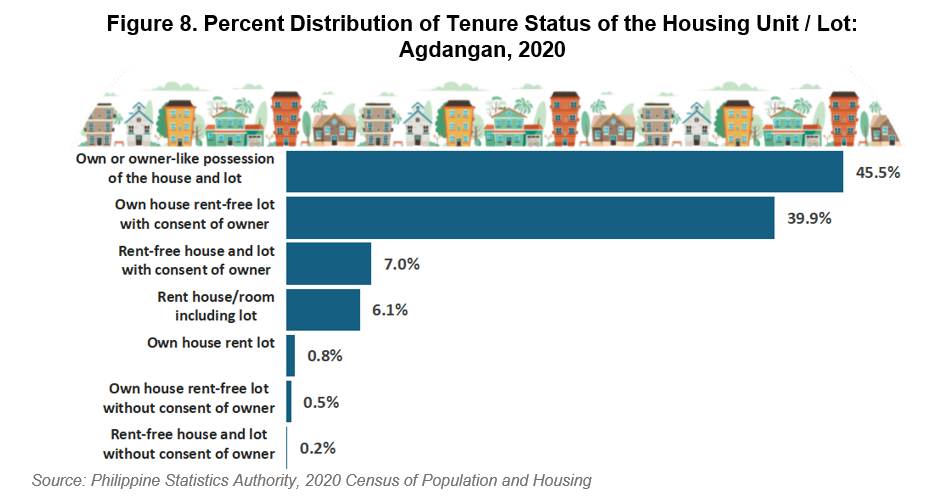
The statistics presented in this Special Release were based on the information provided by the household respondents or any responsible member who provided answers to the questions and gave information about the characteristics of the housing units. For the following data items, observation of the building/housing unit by the enumerator was allowed during the data collection of the 2020 CPH:
1. Type of Building;
2. Number of Floors of the Building;
3. Construction Materials of the Roof;
4. Construction Materials of the Outer Walls; and
5. State of Repair of the building
(SGD.) AIRENE A. PUCYUTAN
Chief Statistical Specialist
PSA Quezon
NDP/MGC/RKS/DOC
